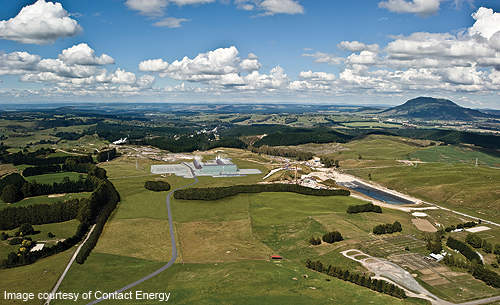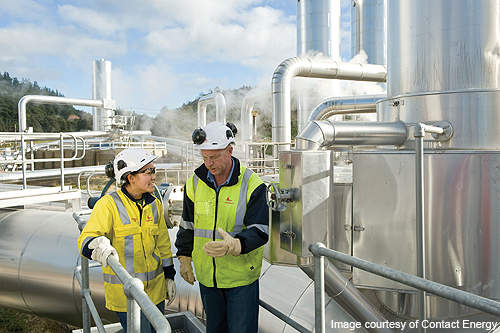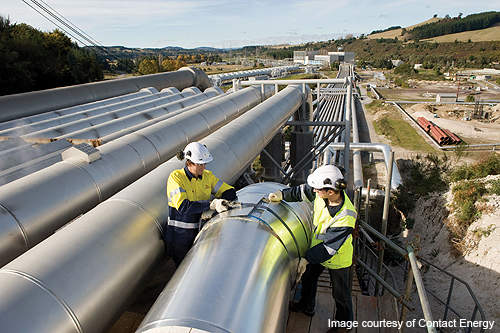The 166MW Te Mihi geothermal power plant has been constructed by Contact Energy on the Wairakei geothermal steamfield in Taupo, New Zealand. Construction of the $750m plant was completed in May 2014.
The Te Mihi project was part of a $750m programme to develop the Wairakei-Tauhara geothermal system. Power generated by the new plant is expected to help in fostering economic growth in the region and providing a secure source of electricity supply.
The power station is built near the existing 54-year-old Wairakei geothermal power plant, which is expected to reach the end of its useful life by 2026. The Wairakei power plant has been subject to frequent maintenance and refurbishments in the recent past. Around 45MW of the old power station is scheduled for decommissioning with the start of operation of the new Te Mihi plant.
Combined output from the two stations will be 114MW, which will be enough to power more than 110,000 homes. A third unit is planned to be added at the Te Mihi station when the Wairakei power plant is fully decommissioned in 2026.
Development of the Te Mihi geothermal power plant
The Wairakei power plant was earlier supplied with steam from the eastern and western borefields on the Wairakei geothermal reservoir. The steam produced by this borefield, however, has been on the decline.
The Te Mihi borefield situated 5km from the Wairakei power plant has, therefore, become the main source of steam supply to the plant.
As the production wells are located farther away from the existing power plant, energy loss from steam transmission has increased.
Building a new plant near the Te Mihi borefield was considered as the best solution to ensure optimal usage of the available geothermal fluid.
The new plant is also expected to bring environmental benefits. The water to cool the Wairakei power plant is currently being sourced from the Waikato River.
The used water containing small amounts of hydrogen sulphide is discharged back into the river, polluting the river water.
To avoid this pollution, a biological treatment facility is built to remove hydrogen sulphide. Wells and piping systems are also included in the project, which enables the separated geothermal water to be reinjected instead of discharging into the river.
Te Mihi Geothermal Power Station details
The Te Mihi power plant features two 83MW steam turbine generators using dual-flash steam separation.
Infrastructure at the plant includes a turbine hall, cooling towers, gas extraction equipment, steam discharge silencers and condensate pipelines.
New production and reinjection wells are drilled into the Te Mihi borefield which generates a mix of dry steam and two phase fluid. The new plant also draws two phase geothermal fluid from the western borefield.
Fluid and steam drawn from the wells is separated into intermediate pressure (IP) steam and geothermal water. The water is flashed to produce low pressure (LP) steam.
Both the IP steam and LP steam are passed to the Te Mihi steam turbine generator sets to produce electricity.
The condensed geothermal fluid and steam condensate are injected back into the ground. Non-condensable gases are removed by gas extractors and discharged to the atmosphere by mixing into the thermally buoyant cooling tower discharge plume.
Wairakei-Tauhara geothermal system grid network
The project involved construction of a switchyard and 2km of 220kV transmission line.
This new line connects to the 220kV Wairakei – Whakamaru transmission line which is part of the national grid.
Key players in plant construction
A consortium consisting of McConnell Dowell, SNC-Lavalin and Parsons Brinckerhoff was awarded the engineering, procurement and construction contract for the plant.
Toshiba International Corporation, a subsidiary of Toshiba Corporation, won a contract to provide steam turbine generator sets for the plant. The turbines are scheduled for delivery in 2012.
Page Macrae Engineering was hired as the head mechanical contractors and was responsible for the off-site fabrication of 1500t of pressure pipe and the site installation, Fiberglass Reinforced Plastic (FRP) piping installation and mechanical installation of the Toshiba Steam Turbine Generators as well as the Balance of Plant (BoP).
MB Century was responsible for the detailed design of the steamfield development which supplies steam to the power plant.
JLE was contracted for the installation of 7,000m of primary ladder rack, 200,000m of low voltage cable and the associated switchboards, motor control centre, and distribution boards. JLE also provided the BoP instrumentation including impulse lines and piping bridals.






